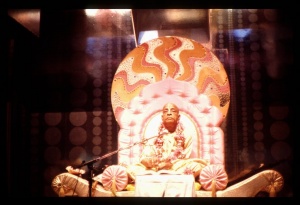CC Madhya 20.124: Difference between revisions
m (1 revision(s)) |
No edit summary |
||
| Line 1: | Line 1: | ||
{{ | [[Category:Sri Caitanya-caritamrta - Madhya-lila Chapter 20|C124]] | ||
<div style="float:left">'''[[Sri Caitanya-caritamrta|Śrī Caitanya-caritāmṛta]] - [[CC Madhya|Madhya-līlā]] - [[CC Madhya 20|Chapter 20: Lord Śrī Caitanya Mahāprabhu Instructs Sanātana Gosvāmī in the Science of the Absolute Truth]]'''</div> | |||
<div style="float:right">[[File:Go-previous.png|link=CC Madhya 20.123|Madhya-līlā 20.123]] '''[[CC Madhya 20.123|Madhya-līlā 20.123]] - [[CC Madhya 20.125|Madhya-līlā 20.125]]''' [[File:Go-next.png|link=CC Madhya 20.125|Madhya-līlā 20.125]]</div> | |||
{{CompareVersions|CC|Madhya 20.124|CC 1975|CC 1996}} | |||
{{RandomImage}} | |||
==== TEXT 124 ==== | ==== TEXT 124 ==== | ||
<div | <div class="verse"> | ||
veda-śāstra kahe—‘sambandha’, ‘abhidheya’, ‘prayojana’ | :veda-śāstra kahe—‘sambandha’, ‘abhidheya’, ‘prayojana’ | ||
‘kṛṣṇa’—prāpya sambandha, ‘bhakti’—prāptyera sādhana | :‘kṛṣṇa’—prāpya sambandha, ‘bhakti’—prāptyera sādhana | ||
</div> | </div> | ||
| Line 12: | Line 16: | ||
==== SYNONYMS ==== | ==== SYNONYMS ==== | ||
<div | <div class="synonyms"> | ||
veda-śāstra | ''veda-śāstra kahe''—the Vedic literature instructs; ''sambandha''—the conditioned soul’s relationship with the Lord; ''abhidheya''—the regulated activities of the conditioned soul for reviving that relationship; ''prayojana''—and the ultimate goal of life to be attained by the conditioned soul; ''kṛṣṇa''—Lord Kṛṣṇa; ''prāpya''—to be awakened; ''sambandha''—the original relationship; ''bhakti''—devotional service; ''prāptyera sādhana''—the means of attaining Kṛṣṇa. | ||
</div> | </div> | ||
| Line 19: | Line 23: | ||
==== TRANSLATION ==== | ==== TRANSLATION ==== | ||
<div | <div class="translation"> | ||
“The Vedic literatures give information about the living entity’s eternal relationship with Kṛṣṇa, which is called sambandha. The living entity’s understanding of this relationship and his acting accordingly is called abhidheya. Returning home, back to Godhead, is the ultimate goal of life and is called prayojana. | “The Vedic literatures give information about the living entity’s eternal relationship with Kṛṣṇa, which is called sambandha. The living entity’s understanding of this relationship and his acting accordingly is called abhidheya. Returning home, back to Godhead, is the ultimate goal of life and is called prayojana. | ||
</div> | </div> | ||
__NOTOC__ | |||
<div style="float:right; clear:both;">[[File:Go-previous.png|link=CC Madhya 20.123|Madhya-līlā 20.123]] '''[[CC Madhya 20.123|Madhya-līlā 20.123]] - [[CC Madhya 20.125|Madhya-līlā 20.125]]''' [[File:Go-next.png|link=CC Madhya 20.125|Madhya-līlā 20.125]]</div> | |||
__NOTOC__ | |||
__NOEDITSECTION__ | |||
Revision as of 10:47, 6 September 2021

A.C. Bhaktivedanta Swami Prabhupada
TEXT 124
- veda-śāstra kahe—‘sambandha’, ‘abhidheya’, ‘prayojana’
- ‘kṛṣṇa’—prāpya sambandha, ‘bhakti’—prāptyera sādhana
SYNONYMS
veda-śāstra kahe—the Vedic literature instructs; sambandha—the conditioned soul’s relationship with the Lord; abhidheya—the regulated activities of the conditioned soul for reviving that relationship; prayojana—and the ultimate goal of life to be attained by the conditioned soul; kṛṣṇa—Lord Kṛṣṇa; prāpya—to be awakened; sambandha—the original relationship; bhakti—devotional service; prāptyera sādhana—the means of attaining Kṛṣṇa.
TRANSLATION
“The Vedic literatures give information about the living entity’s eternal relationship with Kṛṣṇa, which is called sambandha. The living entity’s understanding of this relationship and his acting accordingly is called abhidheya. Returning home, back to Godhead, is the ultimate goal of life and is called prayojana.